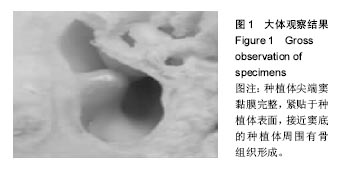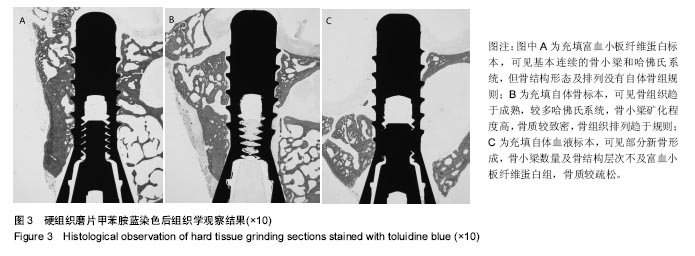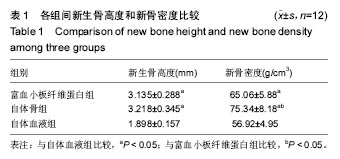| [1]李雅巍,孙晓梅,滕利,等.牙齿种植骨量不足的相关研究进展[J].组织工程与重建外科杂志,2015,11(1):50-54.[2]Geurs N, Ntounis A, Vassilopoulos P, et al. Using growth factors in human extraction sockets: a histologic and histomorphometric evaluation of short-term healing. Int J Oral Maxillofac Implants. 2014;29(2):485-496.[3]Mogharehabed A, Birang R, Torabinia N, et al. Socket preservation using demineralized freezed dried bone allograft with and without plasma rich in growth factor: A canine study. Dent Res J (Isfahan). 2014;11(4):460-468.[4]张文丽,李淑慧,陈诚.PRF复合自体骨髓间充质干细胞修复兔牙槽骨缺损的研究[J].口腔医学研究,2015,31(4):336-339.[5]Dohan DM, Choukroun J, Diss A, et al. Platelet-rich fibrin (PRF): a second-generation platelet concentrate. Part I: technological concepts and evolution. Oral Surg Oral Med Oral Pathol Oral Radiol Endod. 2006;101(3):e37-44.[6]何璇,韦维,陈文霞.富血小板纤维蛋白凝胶三维结构及其对人牙髓细胞外增殖的影响[J].上海口腔医学,2015,24(3):263-268.[7]Nishimoto S, Fujita K, Sotsuka Y, et al. Growth Factor Measurement and Histological Analysis in Platelet Rich Fibrin: A Pilot Study. J Maxillofac Oral Surg. 2015;14(4): 907-913.[8]Ranganathan AT, Chandran CR. Platelet-rich fibrin in the treatment of periodontal bone defects. J Contemp Dent Pract. 2014;15(3):372-375.[9]许方方,刘斌.富血小板纤维蛋白的研究及在组织修复中的应用[J].口腔医学,2015,35(8):691-693.[10]李淑慧,戴晓玮,张文丽.自体骨髓间充质干细胞复合富血小板纤维蛋白促进拔牙窝骨愈合[J].中国组织工程研究, 2016,20(1): 3-7.[11]孙晓琳,翟婧捷,孙悦.PRF联合GBR在前牙即刻种植中的应用1例[J].口腔医学研究,2017,33(1):106-107.[12]郑志平,毛小泉.富血小板纤维蛋白及其在拔牙位点保存中的作用研究进展[J].广西医学,2016,38(11):1589-1591.[13]Kumar RV, Shubhashini N. Platelet rich fibrin: a new paradigm in periodontal regeneration. Cell Tissue Bank. 2013;14(3): 453-463.[14]Jeong SM, Lee CU, Son JS, et al. Simultaneous sinus lift and implantation using platelet-rich fibrin as sole grafting material. J Craniomaxillofac Surg. 2014;42(6):990-994.[15]Tajima N, Ohba S, Sawase T, et al. Evaluation of sinus floor augmentation with simultaneous implant placement using platelet-rich fibrin as sole grafting material. Int J Oral Maxillofac Implants. 2013;28(1):77-83.[16]肖琼,董露,陈红亮,等.富血小板纤维蛋白新生诱导骨的研究进展[J].西南国防医药,2014,24(12):1402-1404.[17]Boyne PJ, James RA. Grafting of the maxillary sinus floor with autogenous marrow and bone. J Oral Surg. 1980;38(8): 613-616.[18]Geurs NC, Wang IC, Shulman LB, et al. Retrospective radiographic analysis of sinus graft and implant placement procedures from the Academy of Osseointegration Consensus Conference on Sinus Grafts. Int J Periodontics Restorative Dent. 2001;21(5):517-523.[19]聂然,杨刚,裴婷婷.骨替代材料在口腔种植骨缺损中的应用研究进展[J].延边大学医学学报,2015,38(2):154-156.[20]Choukroun J, Adda F, Schoeffler C, et al. Une opportunite´ en paro-implantologie: Le PRF. Implantodontie.2001; 42: 55-62.[21]Montanari M, Callea M, Yavuz I, et al. A new biological approach to guided bone and tissue regeneration. BMJ Case Rep. 2013;2013.[22]Lee JW, Kim SG, Kim JY, et al. Restoration of a peri-implant defect by platelet-rich fibrin. Oral Surg Oral Med Oral Pathol Oral Radiol. 2012;113(4):459-463.[23]El-Sharkawy H, Kantarci A, Deady J, et al. Platelet-rich plasma: growth factors and pro- and anti-inflammatory properties. J Periodontol. 2007;78(4):661-669.[24]Ahn JJ, Cho SA, Byrne G, et al. New bone formation following sinus membrane elevation without bone grafting: histologic findings in humans. Int J Oral Maxillofac Implants. 2011; 26(1):83-90.[25]岳增文,曹选平,刘进忠.PRF与Bio-Gide在前牙区种植GBR植骨术中应用的临床观察[J].世界最新医学信息文摘, 2015,55: 31,36.[26]周春梅,温齐古丽•乃库力,于莉.骨诱导活性材料复合富血小板纤维蛋白在拔牙位点引导新骨形成的骨计量学研究[J].临床口腔医学杂志, 2016,32(2):67-69.[27]Tajima N, Ohba S, Sawase T, et al. Evaluation of sinus floor augmentation with simultaneous implant placement using platelet-rich fibrin as sole grafting material. Int J Oral Maxillofac Implants. 2013;28(1):77-83.[28]黄娜,吴锋,李平.应用浓缩生长因子行上颌窦内提升后种植体周围骨变化[J].中国组织工程研究,2015,19(47):7575-7582.[29]Bielecki T, Dohan Ehrenfest DM, Everts PA, et al. The role of leukocytes from L-PRP/L-PRF in wound healing and immune defense: new perspectives. Curr Pharm Biotechnol. 2012; 13(7):1153-1162.[30]戴勇中,叶平.富血小板纤维蛋白的研究进展[J].中华口腔医学杂志,2011,46(6):382-384. [31]Ranganathan AT, Chandran CR. Platelet-rich fibrin in the treatment of periodontal bone defects. J Contemp Dent Pract. 2014;15(3):372-375.[32]Tatullo M, Marrelli M, Cassetta M, et al. Platelet Rich Fibrin (P.R.F.) in reconstructive surgery of atrophied maxillary bones: clinical and histological evaluations. Int J Med Sci. 2012;9(10): 872-880.[33]罗静雯,赵静辉,马珊珊,等.富血小板纤维蛋白的生物组成和功能[J].国际口腔医学杂志, 2014,41(4):448-454.[34]付颖,董庆文,王稚英.富血小板纤维蛋白对牵引成骨区BMP-6表达的影响[J].天津医药, 2016,44(3):261-264.[35]Nakao K, Itoh M, Tomita Y, et al. FGF-2 potently induces both proliferation and DSP expression in collagen type I gel cultures of adult incisor immature pulp cells. Biochem Biophys Res Commun. 2004;325(3):1052-1059.[36]江建林,叶平,吴润发,等. 富血小板纤维蛋白在骨缺损修复中作用的实验研究[J].中国口腔种植学杂志,2015,20(3):101-105.[37]Zhao YH, Zhang M, Liu NX, et al. The combined use of cell sheet fragments of periodontal ligament stem cells and platelet-rich fibrin granules for avulsed tooth reimplantation. Biomaterials. 2013;34(22):5506-5520.[38]符志锋,郭庆平, 繆颖. 上颌窦内外提升不植骨替代材料同期种植牙:随访周围骨量及稳定性的变化[J].中国组织工程研究, 2015,19(3):394-398.[39]Si MS, Mo JJ, Zhuang LF, et al. Osteotome sinus floor elevation with and without grafting: an animal study in Labrador dogs. Clin Oral Implants Res. 2015;26(2):197-203.[40]Pinchasov G, Juodzbalys G. Graft-free sinus augmentation procedure: a literature review. J Oral Maxillofac Res. 2014; 5(1):e1.[41]姚瑶,潘巨利. 上颌窦黏膜在上颌窦提升术中成骨作用的研究进展[J].国际口腔医学杂志, 2015,42(4):432-435.[42]Sohn DS, Kim WS, An KM, et al. Comparative histomorphometric analysis of maxillary sinus augmentation with and without bone grafting in rabbit. Implant Dent. 2010; 19(3):259-270.[43]Ueda M, Tohnai I, Nakai H.Tissue engineering research in oral implant surgery. Artif Organs. 2001;25(3):164-171.[44]Simonpieri A, Choukroun J, Del Corso M, et al. Simultaneous sinus-lift and implantation using microthreaded implants and leukocyte- and platelet-rich fibrin as sole grafting material: a six-year experience. Implant Dent. 2011;20(1):2-12. |
.jpg)




.jpg)